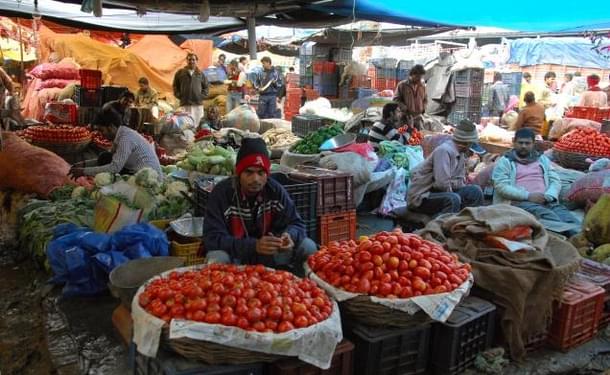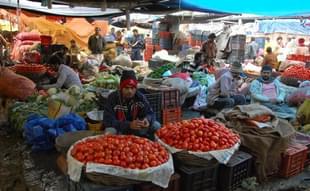Economy
At The Country’s Biggest Fruit And Vegetable Market, Goods Are Changing Hands, Not Cash
Vivian Fernandes
Dec 23, 2016, 12:34 PM | Updated 12:34 PM IST
Save & read from anywhere!
Bookmark stories for easy access on any device or the Swarajya app.


Azadpur mandi is the country’s largest fruit and vegetable auction yard. It is officially designated as a “market of national importance”. Its credibility makes it such a draw, says Satnam Singh, the secretary of Azadpur mandi’s agriculture produce marketing committee (APMC), which runs the show. It gets produce from all over the country: pineapples from Nagaland, coconuts from Kerala, pomegranates from Maharashtra and melons from Andhra. Sixty per cent of Jammu & Kashmir’s apples are auctioned at the yard. It is 78 acres in extent; there are yards that are bigger but none does more business per square metre. On average 14,000 tonnes of produce arrive daily. With 2,200 commission agents and about Rs 9,000 crore in annual turnover it is the busiest. Despite about 20,000 transactions per day, hardly about 10 disputes come to the APMC board for resolution, Singh says.
Trust is the key. Commission agents extend credit to traders and large suppliers and that explains why it is the preferred auction yard. These days there is a missing ingredient. It is cash.
At the kisan shed in the mandi’s vegetable yard, Meher Singh of village Paldi in Haryana’s Sonepat district has sold 15 bags of cauliflower at distress prices. From Rs 10-12 a kg before notebandi, as demonetisation is called in this part of the country, cauliflower rates have dropped to Rs 2 a kg. “Pit gaya ji” (I am ruined), he laments.
Jitender Khokar of village Chaprauli in western Uttar Pradesh sold 800 kg of methi or fenugreek greens for about Rs 3,000. He employs four labourers at Rs 150 each to pluck it. His four family members supplement them. “This should sell for Rs 14-15 for me to recover the cost,” he says.
Farmers at the kisan shed yard pay 1 per cent fee on sales to the mandi. Those who do not have a stall there have to depend on commission agents, who can charge up to 6 per cent.
Babu Chaudhary of village Nangal, also in Baghpat, has sold 600 kg of green chillies at Rs 14 a kg. This is almost half of Rs 25-30 a kg he used to get before 8 November when high value old currency notes got invalidated. After accounting for pesticide sprays and plucking, packing and transport charges little is left, Chaudhary says.
Despite the risks, Chaudhary grows vegetables to give fields a break from sugarcane, the default crop which assures income because state governments fix the prices which mills should pay.
The mandi’s fruit yard is packed with trucks, but their contents are not moving. It is three days since a 16-tonne truck was parked in front of Mohammed Zakir’s stall. He auctions musk and water melons, which arrive from Anantpur in Andhra Pradesh. “I have sold three tonnes so far. Before notebandi, I used to sell at least one truck-load daily,” he says. Zakir has been operating at the mandi since 1994. Bad weather dislocates business temporarily, but he has not seen this kind of prolonged mandi or slump, which is entirely man-made.
Raja Babu, who operates a commission agency named after him, echoes Zakir. The rates of melon have fallen by half after notebandi to Rs 10 a kg, he asserts. The cost of transportation from Anantpur is Rs 4 a kg. Farmers will barely recover their cost at the price melons are fetching. (Prices displayed on the APMC’s website do not show such a drastic reduction. Melons were selling in the range of Rs 300-130 depending on quality before demonetisation. In the first fortnight of December, their prices were in the range of Rs 220-130 per box of 8 kg).
Chandra Mohan says pomegranate rates have fallen from Rs 700 a box of 10 kg to Rs 550, but there are no buyers. Daily sales have declined from about a thousand boxes of 10 kg to Rs 400, he claims. (Official figures show the rate has fallen from Rs 950-1,000 per box of 10 kg for the best grade before demonetisation to Rs 700-750 after the event).
“Currency flow nahin hoga toh grahak nahin ayenge,” (customers will not come if there is no currency flow) says Harbans Lal, a mechanical engineer who gave up employment in a government irrigation department to run his father’s business about 30 years ago, as his salary fell short of his expenses. “Kisan ko bahut nuksan hua hai” (farmers have suffered), he adds.
“Goods are changing hands but cash is not,” says Singh. Suppliers are sending stuff because they know there will be delay, but not default, in payments.
Data from Azadpur mandi’s website shows a mixed picture. Apple arrivals have declined since demonetisation. In the week before notebandi, daily arrivals ranged from 2,050 tonnes a day on 1 November to 3,752 on 7 November. Apple arrivals on 9 November, a day after the announcement of demonetisation, were 3,625 tonnes. They have steadily declined. In the first fortnight of December, arrivals ranged between 2,268 tonnes on 1 December to 1,380 tonnes on 13 December.
Vegetable arrivals do not seem to have been much affected. In the six days before demonetisation in November, potato arrivals averaged 1,495 tonnes. In the first six days of December, they averaged 1,308 tonnes. More onions arrived in the latter period (887.5 tonnes) than in the former (707.5 tonnes). Tomato arrivals in the first six days of November averaged 588 tonnes, while in the first six days of December they averaged 484 tonnes.
Fruits and vegetables being perishable, farmers cannot afford to hold them back. Arrivals perhaps do not reflect the true impact of monetisation. Prices do.
Vivian Fernandes is editor of www.smartindianagricuture.in, a website devoted to promoting modern practices in agriculture including use of genetically-engineered seeds.




